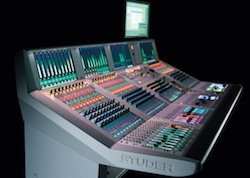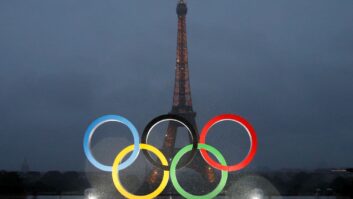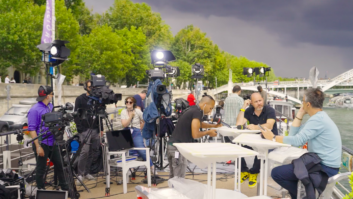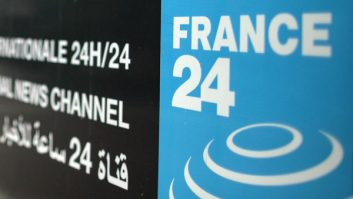
If anybody thinks that mixing audio for TV is a less demanding task than for music, that certainly isn’t a view shared at France Télévisions, not least because of the enormous range of material handled in-house – including complex music set-ups for talk shows. Richard Dean travelled to Paris to see how they work.
Right from the start the French state broadcaster, which produces a daily output of France 2, France 3, France 4, France 5 and the overseas territories service RFO, decided to install a sophisticated sprung floor arrangement to dampen vibrations from the nearby RER (Regional Express Network) railway when it moved to stylish new premises on the site of a former Citroen car factory on the south side of the Seine in southwest Paris in 1998.
With the quickening pace of broadcasting it became increasingly obvious that its remaining analogue production consoles must be upgraded to digital, which among other things would allow more flexibility in assigning studios to different control rooms. So two years ago the company issued a tender for two digital production consoles to equip both Régie 3, the control room for France 3 – the regional TV station with 30 or more TV studios spread around France – and Régie 5 for France 5.
After evaluating competitive systems under the watchful eyes and ears of project leader Lionel Durand (pictured), France Télévisions selected the Studer Vista 9, with a 52-fader board in Régie 3 and 42-fader frame in Régie 5, traditionally used for news and talk shows respectively. The company subsequently became one of the first customers to go on air with the Vista 9 – narrowly beaten by an OB from Euromedia France in August – at France 5 last summer and France 3 this January.
“We actually started the first discussions in May 2009, but the Vista 9 was not due for launch until more than a year later at IBC2010,” says Jean-Philippe Blanchard, Broadcast Division director at Studer distributor Audiopole, who has supplied several Studer consoles to France Télévisions over the years. “However we were able to show a Vista 8 and illustrate the improvements in the pipeline, allowing Lionel to choose the Vista 9 without having seen a console and before the acceptance test procedure.”
Durand had a clear idea of what was required. “Our experience with earlier Vista digital consoles has been good, including a Vista 7 supplied for post production five years ago, but in upgrading these control rooms we wanted to have more extensive metering capabilities and the capability to handle multichannel signals more easily. At Régie 3 we were replacing our last analogue desk – the Studer 980 – so as well as buying a new console we actually built a completely new control room.”
The refurbishment of Régie 3 started in Sept 2010 and took three months with the first tests in December, a talk show with live music being the first programme to air. At the time of our visit, operators were busy mixing, cutting and cueing live satellite feeds from the International World Swimming Competition in Shanghai for France 3, with a separate Chef d’équipements controlling which devices were patched to operators and what images appeared on the screens in the gallery.
Ahead of the curve
In the adjacent audio mixing room, two engineers sat in command of the Vista 9. As well as providing a human backup, the second operator is responsible for communications – and once again France Télévisions is ahead of the curve, as the newly installed Clear-Com talkback system’s MADI (Multichannel Audio Digital Interface) interface was not officially launched until IBC2011.
With some seven matrices, the Clear-Com system is claimed to be one of the biggest yet deployed. These feeds are included in a 64 input/output optical MADI link to the console, massively reducing cable runs at a stroke.
Each talkback and signal feed includes RS232 data that conveys the associated name – from the Clear-Com matrices or the Studer house audio routing system respectively – right on to a display within the appropriate channel strip, taking the guesswork out of source ID.
Lipsync errors are virtually eliminated by using AES 16-channel audio on SDI video, which is de-embedded for mixing and re-embedded for output. Indeed, according to Durand, it is often easier to SDI audio than the traditional ISDN, as it is often difficult to obtain these lines.
“The possibility of using SDI and HD-SDI inputs with 16 channels of audio was very important to us,” says Durand. “The other great advantage of the Vista 9 is the fact that you can put every type of channel on every fader strip, and all within a compact footprint.”
One of the biggest gains of the new installation is the facility to connect the flight-cased Studer stagebox and Sennheiser diversity RF mic stage boxes to any control room by physically wheeling them between studios and patching into the 64-channel MADI i/o fibre connection in each studio. Each slimline cable contains four fibres – two main and two backup.
The alternative would be to have identical microphones in each studio that terminate at a central router, but this would require all equipment to be renewed at the same time – and as any broadcaster knows, equipment replacement is an evolutionary process with no magic wand for instant transformations. So this arrangement is one of those delightfully practical ways of overcoming a problem.
Studio connections
As well as a fibre connection, each studio has local tie lines for analogue mic feeds, which Durand says can be useful when working with two studios. On the console itself, there’s certainly no shortage of the extensive (all TFT-based) metering Durand had hankered after.
As well as a new FaderGlow feature (pictured) that allows groups to be instantly identified with a programmable coloured LED strip alongside each fader, every channel strip has its own mini display right above the fader to save operators the bother of looking up at the wealth of information on what we used to call the meter bridge. Here they will be able to monitor grouped inputs conveniently displayed as adjacent bargraphs, as well as the usual channel and master displays.
“We were already convinced by Studer’s Vistonics interface, but we really needed more detailed bargraphs and the ability to easily control the levels of all the channels of a multichannel signal,” says Durand, who also highlighted the new History mode on the Vista 9. This shows up to 50 seconds of each channel’s output as a green oscilloscope audio waveform trace, which turns red at the point where an overload has occurred.
“For us the History mode is fabulous, and a real plus for the console, as you can easily locate a strange noise or an overloaded signal to a particular fader and react immediately,” he says.
There is no shortage of visual confirmation in the channel strip either, thanks to Vistonics. Above each fader are the three groups of infinite-turn controls for dynamics, parametric EQ and pan position we’ve come to expect from digital desks. However instead of the time-honoured representative numeral or row of dots, the settings of each are displayed here with actual waveforms or positional graphics, displayed in green, red and yellow respectively.
Needless to say the pan group can handle anything from mono to 7.1 channels, but interestingly the display not only indicates spatial positioning but also the bus assignment. All stereo inputs and stereo masters have a correlation meter bar above the bargraph display, which Durand says was crucial to the sale, while the console can process almost 1,000 i/o signals in total.
It all seems like a huge amount of audio muscle to bring into harness for what was once very much the poor relation of video. However Durand is well aware not only of the beckoning demands of HD, but of a more competitive TV market in general as the future unfolds.
So far only France 2 goes out in HD, with 5.1 surround upmixed from stereo, but this will be upgraded to true 5.1 through a new continuity room to be commissioned later this year in time for London 2012 Olympics. Other channels are currently transmitted in SD, but all are equipped for HD production, with 3G-SDI single 2.970Gbps serial links installed throughout.






